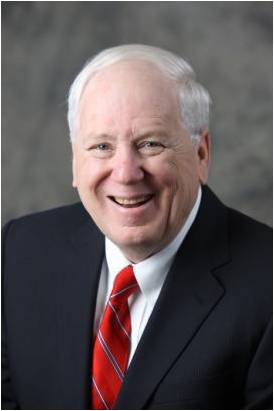
At a ceremony several years ago in Nashville, TN, Kenneth Quinn, then president of the World Food Prize Foundation in Des Moines, was presented the American Farm Bureau’s Distinguished Service to Agriculture Award. As part of the ceremony, Quinn was referred to as the “ambassador for world agriculture.” After she heard him tell the following story, however, Des Moines University President Angela Walker Franklin, Ph.D., said she believes it might be just as appropriate for Quinn to be known as the “ambassador for osteopathy.”
Former U.S. ambassador to the Kingdom of Cambodia, Quinn assumed the leadership of the World Food Prize Foundation on Jan. 1, 2000, following his retirement from the State Department after a 32-year career in the Foreign Service. He retired from the World Food Prize Foundation in 2020. Below, he describes his experience as a patient of and believer in osteopathic manual medicine.
The debilitating lower back pain that I suffered from during much of my youth reached its zenith in 1972 while I was assigned as a wartime development advisor in the remote province of Chau Doc along the Cambodian border in the Mekong Delta of South Vietnam. While in my quarters, a sudden seizure sent a bolt of electricity up my spine and into my brain (I can still visualize the streak of blue light that I saw), knocking me off my feet and leaving me prone and helpless on the floor. Even the slightest twitch sent further jolts of current up my back with pain so agonizing that it made me scream. I was afraid I might never walk again. All I could do was hope that eventually someone would find me. Several hours later, they finally did. Like a dead Viking warrior, I was placed on an old door and carried aloft by six medical evacuation team members. They slid me, door and all, into a work-horse UH-1 Army helicopter for the hour-and-a-half trip to Saigon, with my toes dangling out the door the entire flight.
Despite x-rays and other examinations, no one could find what had caused the attack I had experienced. Eventually, with continuous rest, my back spasms subsided and I was finally able to gingerly move about. However, I was bent sideways to the left and would remain that way for weeks at a time. Neither the state-of-the-art mechanical stretching machines at the Vietnamese National Orthopedic Center nor acupuncture from Chinese traditional medicine purveyors in the back alleys of Saigon provided any relief.
After finishing my time in Vietnam in 1974, I spent two and a half years as a State Department officer in Washington assigned at the National Security Council at the White House. In 1978, under a special State Department program, I was “loaned” to Iowa Governor Bob Ray, arriving in Des Moines just in time for another severe attack. The governor’s chief of staff, Wythe Willey, startled to see me walking bent over to the left, advised me to go to the osteopathic college located in the old St. Joseph’s Academy on Grand Avenue. As nicely as I could, I thanked him but assured him I had tried every medical remedy imaginable and nothing ever worked. Wythe persisted in telling me that “these guys are really good.” Finally, more in an effort to get him off my back than anything else, I agreed I would visit the clinic, certain in my own mind that it would be one more wasted effort.
I still have the most vivid memories of limping my way back to the old classroom building (still standing) where Dr. Bernard TePoorten had his office. Severely bent over to the left, I took the seat that he offered, a very uncomfortable hard chair. I remember being mildly upset that, despite seeing I was so visibly twisted, he made me sit and converse with him while he chain smoked. At the same time, I could not complain too much since, as I best recall, the visit was only going to cost $15.
After what seemed to be an interminable period, he had me crawl up onto the examining table and lie down on my back. Then, this tall, thin man, in his long white coat, bent my left knee up and leaned his body against it. He then reached his right hand under my right shoulder, and, in what I came to understand is a “high speed manipulation,” simultaneously pushed my knee and pulled my shoulder in opposite directions, causing a loud cracking sound in my back. He then went around the table and repeated the procedure with the opposite knee and shoulder.
Dr. TePoorten then told me to stand up. I did, with my body still severely twisted to the left. He asked me, “Why are you standing like that?” “Because I can’t straighten up!” I replied. “Yes, you can!” he answered. “Try it!”
Slowly, I started to move my head and shoulders from their bent position to being straight and upright, bracing myself for the pain I was sure would follow. And then, in what can only be described as a moment of miraculous ecstasy, my agony was over. The pain was completely gone. I was able to straighten up without pain or discomfort for the first time in more than six years. I was stunned and speechless at what had happened; Dr. TePoorten was transformed in my eyes from a doctor at a relatively little-known medical facility into a miracle worker of biblical proportions. He had done what no other medical professional or healer had ever been able to do.
When I was finally able to come up with some words, I effusively thanked him. The depth of my gratitude was such that, if Dr. TePoorten had decided to lead some type of global osteopathic healing pilgrimage, I likely would have been prepared to leave home, become his disciple and follow him anywhere. Thank goodness he decided to stay in Des Moines so that I could remain with my family and go back to him on occasion whenever I needed some adjustment.
With low back syndrome being what it is, from time to time I continued to have problems. While I have been blown up, wounded, shot at and under death threats in every diplomatic assignment I ever had, one of the things I dreaded most was hosting or attending cocktail receptions, since standing for an hour could trigger the onset of another “back attack.” For example, in Cambodia as U.S. ambassador in 1997, during an intense period of violence, I experienced another severe set of spasms that once again left me flat on the floor in my ambassadorial office, unable to move. When a newly arrived embassy officer came in looking for me, she thought I had died of a heart attack and was phoning Washington to report my demise. I finally managed to moan to let her know I was alive. Thankfully, there were some French chiropractors in Phnom Penh who could do what I called the “TePoorten maneuver” to get me literally and figuratively back on my feet.
Now back in Des Moines, I take comfort in the fact that Des Moines University is still just a few blocks away. I have been treated by both Dr. David Boesler, past osteopathic manual medicine department chair, and most recently by Dr. TePoorten’s son-in-law, Dr. G. Bradley Klock. While these physicians’ approaches to manipulation differ, the results for me have been the same.
I am so grateful for the amazing relief that Des Moines University has provided me that I told both former DMU president and now Iowa Governor Terry Branstad and current President Dr. Angela Walker Franklin that, should they need someone to go on camera with a public service announcement about the efficacy of osteopathic manipulation, all they have to do is give me a call. It would be the least I could do to pay back Dr. TePoorten for that “Miracle on Grand Avenue” 35 years ago.

